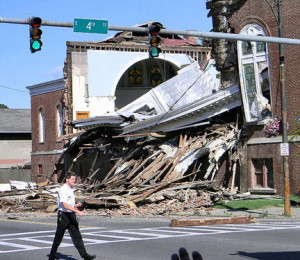 http://www.9wsyr.com/news/local/story/Oswego-Church-collapses-but-memories-remain/JSijb-ftPkCAV8-MVti2dQ.cspx?rss=1543
http://www.9wsyr.com/news/local/story/Oswego-Church-collapses-but-memories-remain/JSijb-ftPkCAV8-MVti2dQ.cspx?rss=1543
Street vendors sold hotdogs in the empty building’s shadow and people celebrated with loud music at a local festival on nearby streets. The church looked so normal. Yet without warning, St Louis Catholic church in Oswego, NY, partially collapsed to the pavement this past weekend. Fortunately no lives were lost in the immediate catastrophe.
The more I have viewed pictures and read about it on the internet, the more I have been haunted by the thought. On one level, I suppose, it is just the story of another closed and unsold church, neglected for years that simply reached the point of architectural instability. It sounds so mundane.
But I see it differently. From my vantage point, this historical exclamation point is a powerful symbol of a much more crucial and deadly collapse that happened without much notice many years before; a collapse that is being repeated all across America today in churches Catholic and Protestant. The paper reported tersely that the church closed ten years ago because of a decline in parishioners. That is the real collapse, the death of a congregation by withering away. How many souls have missed the way because that light has been darkened? How does that happen? Can it happen to our church as it has to St John the Evangelist in Syracuse and many others?
A visible collapse like this one makes us all stop and think about it. Now I know that church attendance can be a tricky subject. Demographic, competitive, leadership and location factors certainly play a role. Something as simple as a building with no parking could doom a congregation to decline during the latter 20th century.
But the factor in potentially losing a church to neglect that troubles me the most is one that we can do the most about, or can we? I’m afraid that closed and neglected church buildings are a sign that Americans do not value anymore what our forefathers who built these churches valued. The sign of it is that weekly, we trade in our heritage of faith for Sunday entertainment, leisure, travel, shopping, or sports. So though we claim to be Christian, we are no-shows repeatedly. These other things are more fun and satisfy our eyes’ desire to see new things and our insatiable craving for pleasure; but they leave our souls starving. The predictable result is that our moral values are unfortified with deep reasons from the wells of faith; our children do not learn the didactic stories of Scripture; and we are left without the comfort and support of a family of faith.
In contrast, our forefathers understood what David meant when he said, “You are awesome, O God, in your sanctuary; the God of Israel gives power and strength to his people. Praise be to God!” (Ps 68:35 NIV). That is why they invested, often heavily in making the place of his praises majestic. If we do not understand their investment of money, labor or time in attending, perhaps we should ask if we are missing something, before the church we look to as home collapses from inside. Much later someone will raze the external skeleton and no one will be left to mourn.
“The Lord made the heavens.
Splendor and majesty are before him;
strength and glory are in his sanctuary.” (Ps 96:5-6)